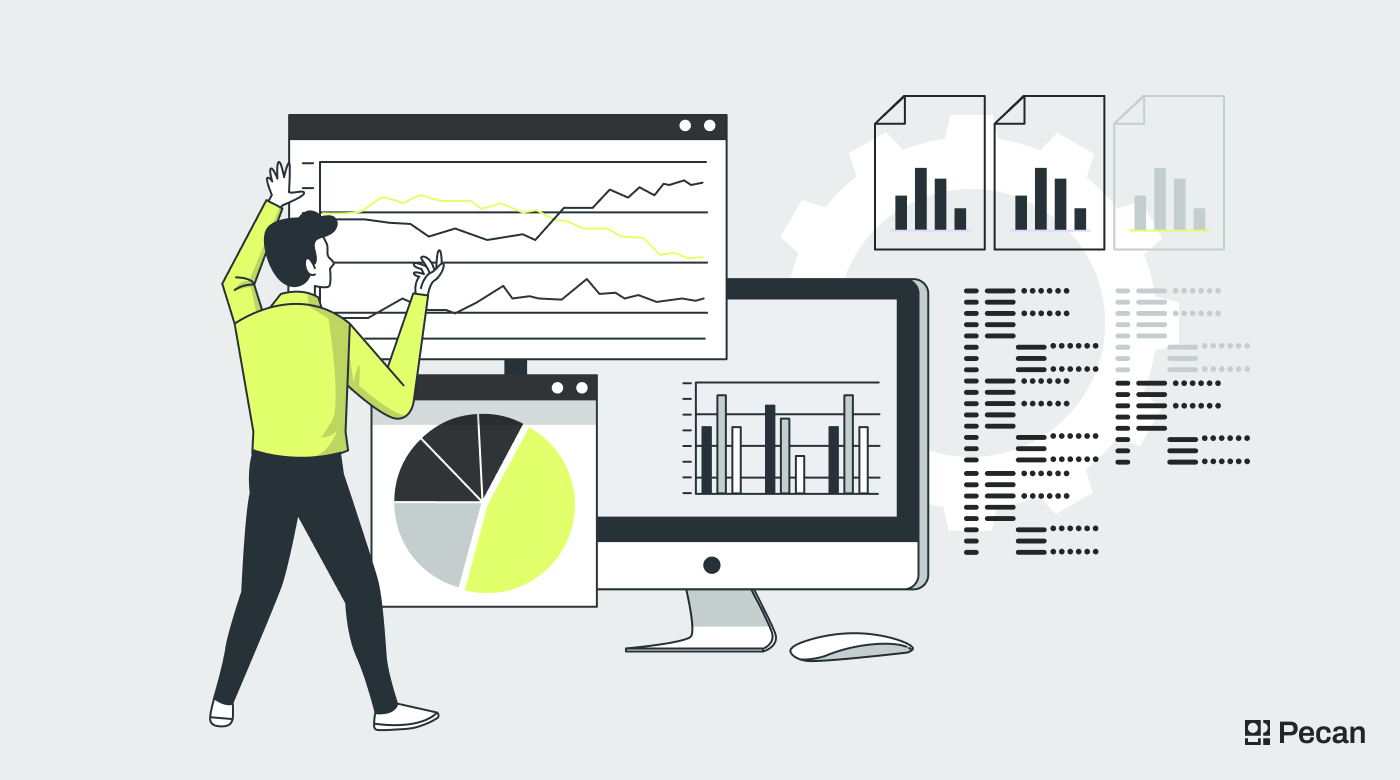In a nutshell:
- AI predictive modeling uses machine learning and deep learning to analyze data and predict future outcomes.
- It can be used in various industries like insurance, hotels, and banks.
- Benefits include identifying hidden trends, making better business decisions, improving operations, and facilitating scalability.
- Drawbacks include reliance on data quality, ethical concerns, and high setup costs.
- Pecan is an AI platform that automates predictive modeling, making it accessible and cost-effective for businesses.
Regardless of how anyone feels about it, artificial intelligence (AI) is here to stay. It’s transformed the way many of us live our lives. Its impact is present in business, entertainment, healthcare, and education. However, there’s much more to artificial intelligence than chatbots and tools like ChatGPT. Predictive modeling is one of AI’s less glamorous but highly impactful aspects.
In this article, we’ll discuss what AI predictive modeling is, its benefits, and its drawbacks. We’ll also discuss how Pecan can help your business make better decisions and gain higher ROI through predictive modeling.
What is AI predictive modeling?
AI predictive modeling uses Machine Learning (ML) and Deep Learning (DL) to analyze past and current data to predict future outcomes. Predictive modeling starts with data gathering, after which the data is analyzed, and a predictive model is used to generate likely outcomes.
Predictive modeling can be used in a wide range of instances and industries. For example, insurance companies can predict which additional policies a customer might be interested in purchasing. Hotels can find out which holiday dates they’re likely to be overbooked. Banks can predict which transactions are likely to be fraudulent and so much more.
AI predictive analysis isn’t a one-time event, however. The models must be constantly updated with new data to ensure accuracy. Adding new information and changing external conditions can make old forecasts useless.
There are different types of predictive models. Here are four of the most common predictive analytics models used today:
- Classification model: This is one of the simplest models available. It’s often used to predict between two outcomes, e.g., True/False, Yes/No, but it’s also possible to predict more than one outcome (e.g., High/Medium/Low).
- Forecast model: This concerns numerical forecasts based on previous data. For example, it can help an office supply store predict the number of backpacks to stock before a new school session starts.
- Clustering model: The clustering model identifies and categorizes data based on similar factors into different groups. It’s often used when there’s no prior knowledge of the groups and characteristics to be analyzed. These clusters are then used as input for further analysis.
- Time series model: This predictive model uses data from a given period to predict future events. For example, it can involve analyzing the sales of a particular product within the last three months to predict sales for the next three months.
What are the benefits and drawbacks of AI predictive modeling?
AI predictive modeling is an excellent tool for businesses, and it comes with a specific set of benefits and challenges. In this section, we’ll cover some of the benefits and drawbacks of predictive analytics.
Benefits of AI predictive modeling
1) Identify hidden trends
Unlike humans, computers are great at identifying trends in customer behavior. This allows businesses to accurately identify and capitalize on critical characteristics that improve their bottom line. Such hidden trends include things like which customers will be most likely to be upsold.
2) Make better business decisions
Predictive modeling removes the guesswork from making the best business decisions. By analyzing a wide range of data points, this method can pinpoint which activities or behaviors may predict specific outcomes. For example, based on previous and current data, you can predict your customers’ lifetime value (LTV).
3) Improve operations
By accurately predicting future outcomes, businesses can improve their processes, improve the customer experience, and accurately prepare for future demands. For example, a gift retailer can accurately determine which types of gifts run out faster and must be restocked before the holidays. This prevents businesses from overstocking low-selling items and sending “this item is unavailable” messages to willing customers.
4) Facilitate scalability and continuous improvement
Businesses generate more accurate and relevant predictions by regularly updating predictive models with new data. This means that your business can scale effectively without any extra costs.
Drawbacks of AI predictive modeling
1) Reliant on the quality of data
The common phrase “garbage in, garbage out” applies especially to predictive analysis. Predictive models cannot verify the quality of the data they’re provided for training. As a result, mistakes, errors, or biases during the data-gathering process can render the forecast useless. Investing in data cleanliness is essential, whether that means a careful preparation process by hand or using an automated tool like Pecan that prepares your data.
2) Ethical concerns
Data privacy continues to be a concern for many with regard to artificial intelligence. Determining the best process for collecting, storing, and using customer data can be tricky. 30% of professionals surveyed for the Thomson Reuters Future of Professionals report mentioned that their most significant concerns regarding AI are data security and ethics.
3) Expensive to set up
Predictive analytics involves several processes — data collection, cleaning, analysis, and more. Specialized knowledge can be required at each stage. As a result, a productive data team can be costly to set up and maintain.
These are all significant issues when deciding whether to invest in predictive modeling. However, AI-powered predictive analytics software such as Pecan is great at addressing most of these issues. Pecan also places a high premium on security, ensuring your data is well-protected. Most importantly, Pecan solves a wide range of data-related problems, automates the tricky parts of the predictive modeling process, and is a lower-cost option to hiring an entire data team.
AI predictive modeling FAQ
How is AI used for prediction?
Artificial intelligence uses several steps to predict future events by applying machine learning techniques. Here are a few of the steps required:
- Data collection: This refers to collecting relevant data from various sources. They can be historical data, real-time data, or a combination of both.
- Data cleaning: Data is often unusable in its raw form; proper cleaning and scrubbing must be done to prevent errors in the datasets, address outdated information, and make it usable for predictive modeling.
- Feature selection: Features are specific attributes within a dataset you want your model to be trained on. You can think of them as variables or characteristics of the things you want to make predictions on; for example, a customer’s age or geographic location is a feature.
- Model selection: This involves choosing the models to be used based on the data, the prediction task, and the specific machine learning algorithm that performs best in testing.
- Training and testing the model refers to feeding the model with historical data to learn patterns, relationships, and trends. The model is also tested using new data to ensure it can be generalized to make accurate predictions when it looks at new data.
- Prediction: Once validated, the AI model is ready to use new data it’s never seen before to make accurate predictions.
- Monitoring and maintenance: Regularly updating data and monitoring the predictive models is necessary to ensure the accuracy of new predictions.
What is an example of predictive modeling?
Predictive modeling can be used in a wide variety of industries and businesses. An example is a logistics company using predictive analysis to forecast how many packages will need to be delivered daily based on previous years’ data.
Using a time series model, they can accurately predict the number of packages they can expect based on data from the last six months or the same period over the last ten years. This forecast will help them better prepare for the workload and ensure they have the proper staffing and equipment when and where they will be needed.
How do you enhance the performance of an AI prediction model?
There are several ways to improve the performance of your AI prediction model. Here are a few techniques to consider:
- Data quality: Ensure your data is accurate and applicable to the predictions you want to generate.
- Pick the right algorithm: There are different algorithms for predictive modeling, such as decision trees, neural networks, and more. Each of them has strengths and weaknesses based on the nature of the data and forecasts to be made. Ensure you select the suitable algorithm. (Pecan will handle this process for you, so don’t worry if this sounds daunting.)
- Fine-tune your parameters: Test different combinations of hyperparameters to determine the best option for generating the most accurate predictions. (Again, we’ve got you covered here.)
- Monitor your models: Models aren’t static. They must be constantly monitored, especially with new data and changes implemented using models. You’ll want to ensure that they are still offering accurate predictions.
Setting up a data team to do all this may not be possible for every company. However, there are several low-code predictive analytics platforms, such as Pecan, that may be able to help you handle the above steps.
How does Pecan use AI predictive modeling?
While the impact of AI and predictive analytics continues to grow, unfortunately, its full capacity isn’t available to most businesses. Free tools like ChatGPT have allowed many to play with powerful AI on a personal level. However, the more beneficial tools, especially those dealing with predictive modeling at the scale of enterprise businesses, often require extensive costs.
Data must be correctly collected and stored before predictive analytics is done, and then data cleaning must occur. This often requires dedicated teams of specialized data scientists and analysts, which can be expensive.
This is where Pecan comes in. It helps businesses automate their AI predictive modeling without needing any data science or coding experience. This ease of use gives smaller businesses a competitive advantage over similar companies.
There are several benefits of using Pecan AI:
- No prior data science experience is needed. Once your data is plugged into Pecan, it automatically cleans it, analyzes it, creates suitable predictive models, and provides easy-to-understand predictions based on the data gathered.
- No data preparation needed: Creating accurate forecasts can be a complicated process, involving different steps and requiring multiple data specialties such as data analysis, cleaning, etc. With Pecan, all this is automatically done for you. Your team can quickly get predictions without working manually through any of these stages.
- Clear outcomes: For a forecast to be helpful, it must be easily understandable. A common problem businesses face is bridging the disconnect between what their data indicates and what steps to take. This is where Pecan stands out. It uses multiple data points and other relevant factors to generate predictions. This ensures that each prediction is actionable at the granular customer level.
- Ease of use: Pecan is a low-code platform that provides actionable predictions without data science or coding. It also integrates effortlessly with the rest of your existing tech.
- Cost-saving: Setting up and maintaining a huge team of data scientists and analysts can cost hundreds of thousands of dollars. With Pecan, you can access various predictive modeling capabilities that your existing staff can use.
Here’s how Pecan helped CAA Club Group to enhance service quality, reduce time spent forecasting by 30%, and boost member satisfaction throughout the entire service region, all while increasing the efficiency of their in-house data team.
Make better business decisions with AI predictive modeling
With a platform like Pecan, you can generate high-level predictive models and predict future outcomes without data science or coding experience. Pecan doesn’t require any data preparation or engineering — you connect it directly to the raw data, and the entire process is automated.
Businesses that can effectively utilize AI predictive modeling will improve customer satisfaction, improve brand positioning, and generate more profit. Try Pecan for free today or schedule a demo, and start accurately predicting future business trends before they happen.







